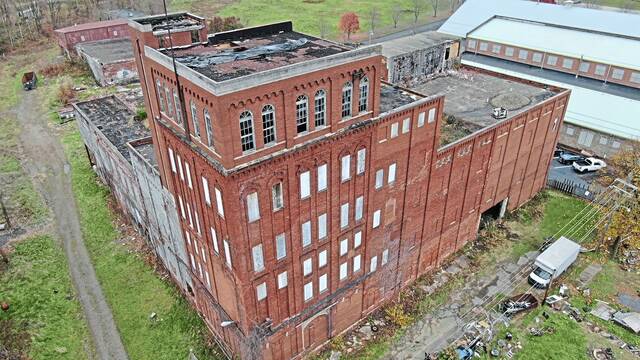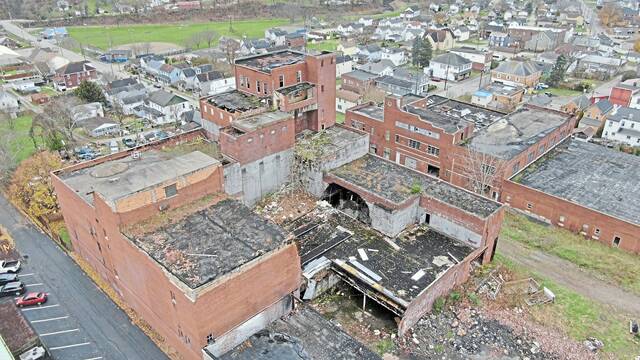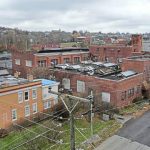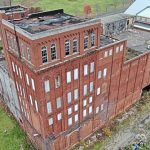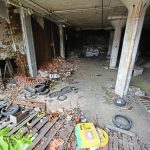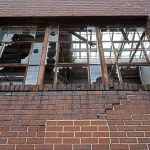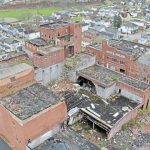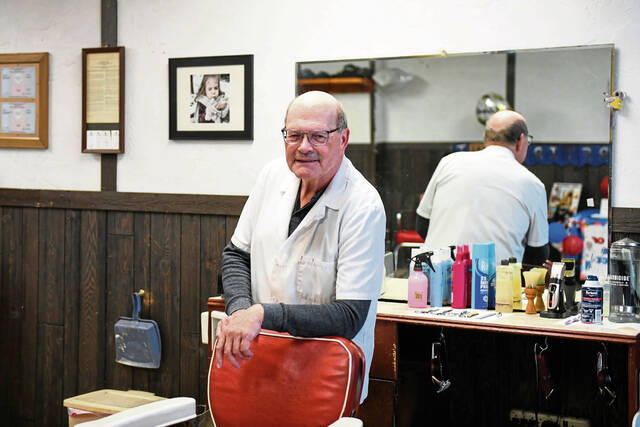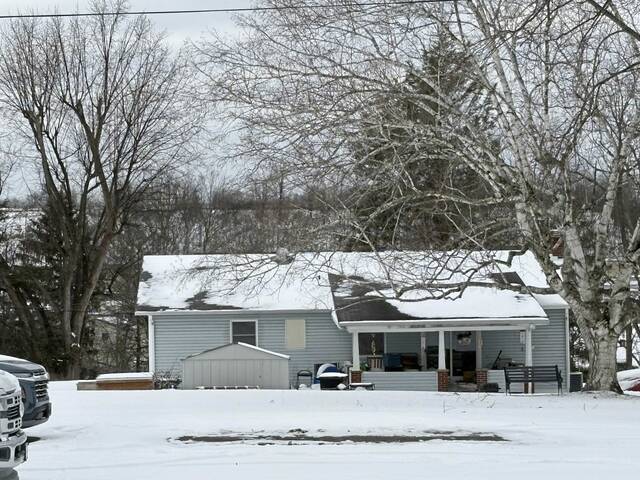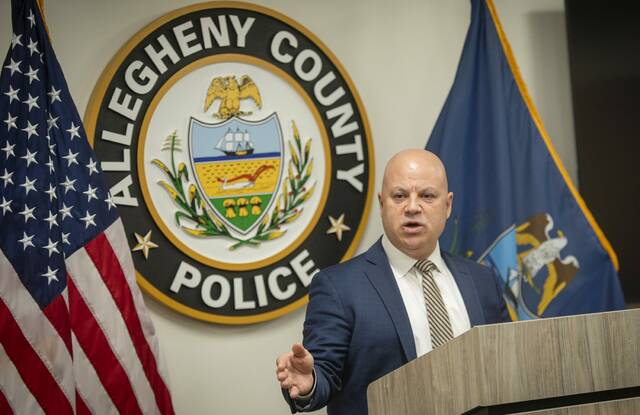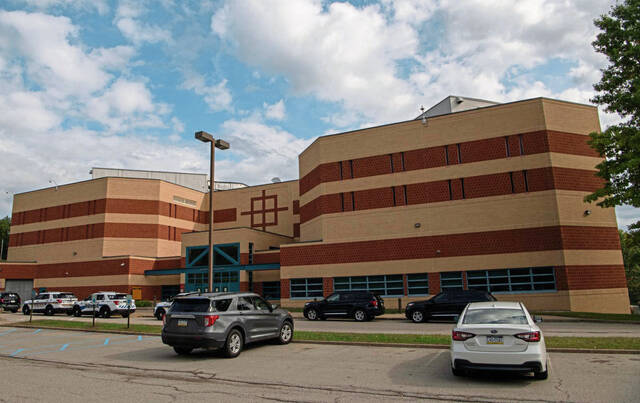Bob and Lola Barton see the decrepit remains of the former Fort Pitt Brewery every time they leave home.
The West Jeannette couple said the crumbling, red-brick complex attracts rodents and troublemaking kids who have thrown rocks from the roof. The Bartons have lived on 11th Street for about 25 years. They remember when businesses operating in the buildings were forced out by new ownership.
Since then, it’s been nothing but a nuisance — a mammoth structure left to rot on the edge of a neighborhood so many families call home.
“They need to do something with it,” Bob Barton said. “It’s a shame that that building got like that because I’m sure at one time that would’ve been a good landmark.”
Lola Barton agreed: “It should’ve been taken down a long time ago.”
It’s a familiar scene in Jeannette.
A huge building where people once earned a living now is a playground for vagrants and a drag on city resources. Ownership issues stymie progress in getting the property back on the tax rolls, resulting in large sums of public money being spent to acquire and demolish buildings.
Similar stories played out at the former Monsour Medical Center and the old Jeannette Glass plant. The brewery buildings, nestled between Penn Avenue and Clay Avenue Extension, could be a sequel — as well as yet another opportunity. Revitalizing the site, a stone’s throw from Jeannette Industrial Park, could be a key part of helping the city build on its recent progress, said Nathan Bish, city clerk.
“That really is the last big piece, and so we can start trying to rebuild a better image,” he said.
‘Progressively worse’
Frank Trigona’s Rufus Corp. bought the defunct Fort Pitt Brewery property in 2002. He died in 2015, leaving behind 20 vacant parcels in Jeannette. The executor — who also since has died — said at the time that the businessman’s estate didn’t have any way to pay delinquent taxes, which date to 2005 and now total about $330,000 on the brewery property alone.
The multi-building complex has been getting “progressively worse” over the last several years, said Fire Chief Bill Frye. Openings to the inside show fallen bricks, spray paint and old tires. Broken windows are visible on Penn Avenue. Several doors stand open or busted out. A large section of a rear wall has collapsed, and parts of several roofs are missing, including on one building that is separated from homes only by an alley.
The size of the complex makes it impossible to secure, leaving it a target for vandals, Frye said.
Nearby resident Conway Hemminger said children play inside daily after school, and he fears someone may get injured. He realizes the cost of clearing the land and lack of funding is hindering progress.
“That building does hurt a lot of property around here,” he said.
A suspicious fire in July 2017 caused further damage. Then, part of a single-story building the size of a football field went up in flames, resulting in a partial collapse and water main break that flooded several homes.
“There’s nobody to hold accountable,” Frye said. “My biggest concern now is collapsing and somebody getting hurt in there.”
‘Need to be addressed’
The Westmoreland County Industrial Development Corp. stepped in with similar situations at the former Jeannette Glass and Monsour Medical Center properties. Buildings at both had become dangerous eyesores. Public money was used in recent years to acquire the properties, demolish abandoned structures and prepare them for redevelopment.
The former Jeannette Glass site has since been replaced by Elliott Group’s new cryodynamics testing facility. A grass lot has sprouted at the former medical site along Route 30, though development plans have not been announced.
It would cost at least $1 million to tear down the old brewery and prepare the property for redevelopment, estimated Jason Rigone, WCIDC director. County officials are aware of the issue, but other projects are a priority right now, he said.
“These kind of projects are certainly ones that need to be addressed,” Rigone said.
Blight can cause many potential ripple effects on a community, from lower property values to diminished learning abilities for the youngest neighbors, said Joe Schilling, senior policy and research associate at Urban Institute in Washington, D.C. He worked with officials in Memphis six years ago on the creation of a charter that helped blight-fighting groups collaborate.
Those kinds of partnerships are “the only way to address a complex problem like vacant and blighted properties,” he said. “The local government can’t do this on their own.”
Members of the Memphis charter continue to meet and have a regular summit to honor those who have made a difference and find ways to keep making progress, Schilling said. The charter process is one that was adapted from similar projects elsewhere like in Cleveland, where the Vacant and Abandoned Property Action Council still meets regularly after its inception in 2005, he said.
“It really is a community problem, and the cost of doing nothing means you have impacts on a particular neighborhood and those impacts just kind of reverberate,” he said.
Success stories
For places like New Kensington and Wilkinsburg, creative approaches have erased blight through concerted efforts and partnerships.
The Corridor of Innovation in New Kensington, which encompasses five blocks on Fifth Avenue, started with hopes that movement there would catch on elsewhere in town, said Sarah Snider, who volunteered as coordinator when the project was in its infancy. The corridor had its official public debut in 2017. Now business owners and other community leaders have continued to carry the torch as new shops, restaurants, medical complexes and even a park line the street.
“It’s the coming together of all of the different partners that really gives you the power and strength to start seeing it climb up that mountain to success,” she said.
While there is still work to be done, it could absolutely be replicated in other communities, Snider said.
The Pittsburgh History & Landmarks Foundation has improved housing quality in Wilkinsburg through several multi-million dollar residential historic restoration projects over the past 15 years with the help of public and private funding as well as tax credits. Director of development and communication Karamagi Rujumba said those projects reinvigorated communities in a way that didn’t displace residents.
“(Blight) is a self-fulfilling cycle,” he said. “The blight causes a loss of confidence, a loss of investment in the community. It creates opportunity for crime and lack of safety.”
Brewery history
There was a time when the brewery buildings were thriving.
Victor Brewing Co. was organized at the site in 1907, with the capacity to produce up to 150,000 barrels of beer — making it one of the largest operations in the region, according to news accounts. It operated until Prohibition in 1920, employing about 350 people.
The company resumed operations when Prohibition ended in 1933 but went into bankruptcy in 1941. It was bought that year by Sharpsburg-based Fort Pitt Brewing for $350,000, according to news accounts.
Fort Pitt continued brewing at the plant until 1955. It consisted of 15 buildings on 6 acres — a three-story bottling building, a six-story brewery, a garage, warehouse, loading dock and other structures.
By 1956, the owner was considering other uses for the site and later sold much of the brewing equipment for $500,000 to a Mexican firm. The following year, the property was sold to Fidelity Trust Co. for $125,000, according to deeds. Papercraft Corp. expanded its gift wrap manufacturing operations there from its headquarters in Pittsburgh. The Jeannette plant continued operations until the mid-1970s, then was dormant for several years.
In the late 1980s, the property was sold to Laurel Mould for $226,000, according to a deed. The company produced plastic food containers and employed about 160 people. It’s unclear when manufacturing ceased.
The property was sold at sheriff’s sale in 2001 for $58,820 to First Union Small Business Capital.
It last changed hands a year later when Trigona’s Rufus Corp. bought it.
‘It would be a wow’
The property is working its way through the judicial sale system. City leaders said it could be a potentially valuable location that is under consideration for inclusion in a tax incentive program. Officials are working on creating Local Economic Revitalization Tax Assistance designations around the city in an effort to spur investment by offering tax abatement for property improvements.
Mayor Curtis Antoniak said he thinks that could ultimately help a developer take on a project that is not affordable for the city to tackle.
“That property, if it was developed, it would be a wow,” he said. “I am very concerned it’s starting to fall.”
City and county leaders agree it needs to come down, but when and how remain the big questions.
“It’s just a matter of opening up capacity and finding funding,” Rigone said. “It’s going to have to take a proactive approach to address.”



